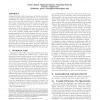Free Online Productivity Tools
i2Speak
i2Symbol
i2OCR
iTex2Img
iWeb2Print
iWeb2Shot
i2Type
iPdf2Split
iPdf2Merge
i2Bopomofo
i2Arabic
i2Style
i2Image
i2PDF
iLatex2Rtf
Sci2ools
WMCSA
2016
IEEE
2016
IEEE
How to Safely Augment Reality: Challenges and Directions
Augmented reality (AR) technologies, such as those in headmounted displays like Microsoft HoloLens or in automotive windshields, are poised to change how people interact with their devices and the physical world. Though researchers have begun considering the security, privacy, and safety issues raised by these technologies, to date such efforts have focused on input, i.e., how to limit the amount of private information to which AR applications receive access. In this work, we focus on the challenge of output management: how can an AR operating system allow multiple concurrently running applications to safely augment the user’s view of the world? That is, how can the OS prevent apps from (for example) interfering with content displayed by other apps or the user’s perception of critical real-world context, while still allowing them sufficient flexibility to implement rich, immersive AR scenarios? We explore the design space for the management of visual AR output, propose a design ...
| Added | 11 Apr 2016 |
| Updated | 11 Apr 2016 |
| Type | Journal |
| Year | 2016 |
| Where | WMCSA |
| Authors | Kiron Lebeck, Tadayoshi Kohno, Franziska Roesner |
Comments (0)

